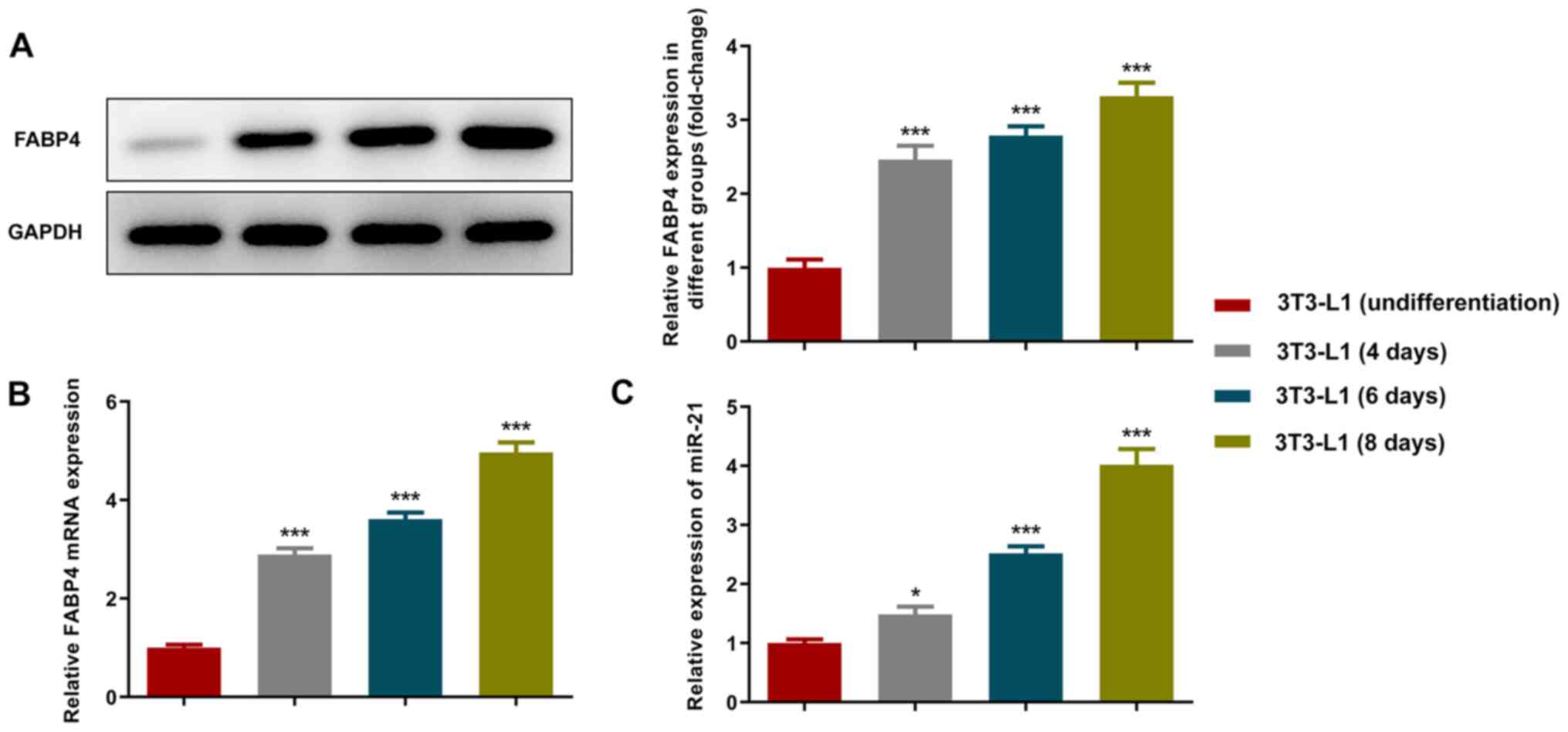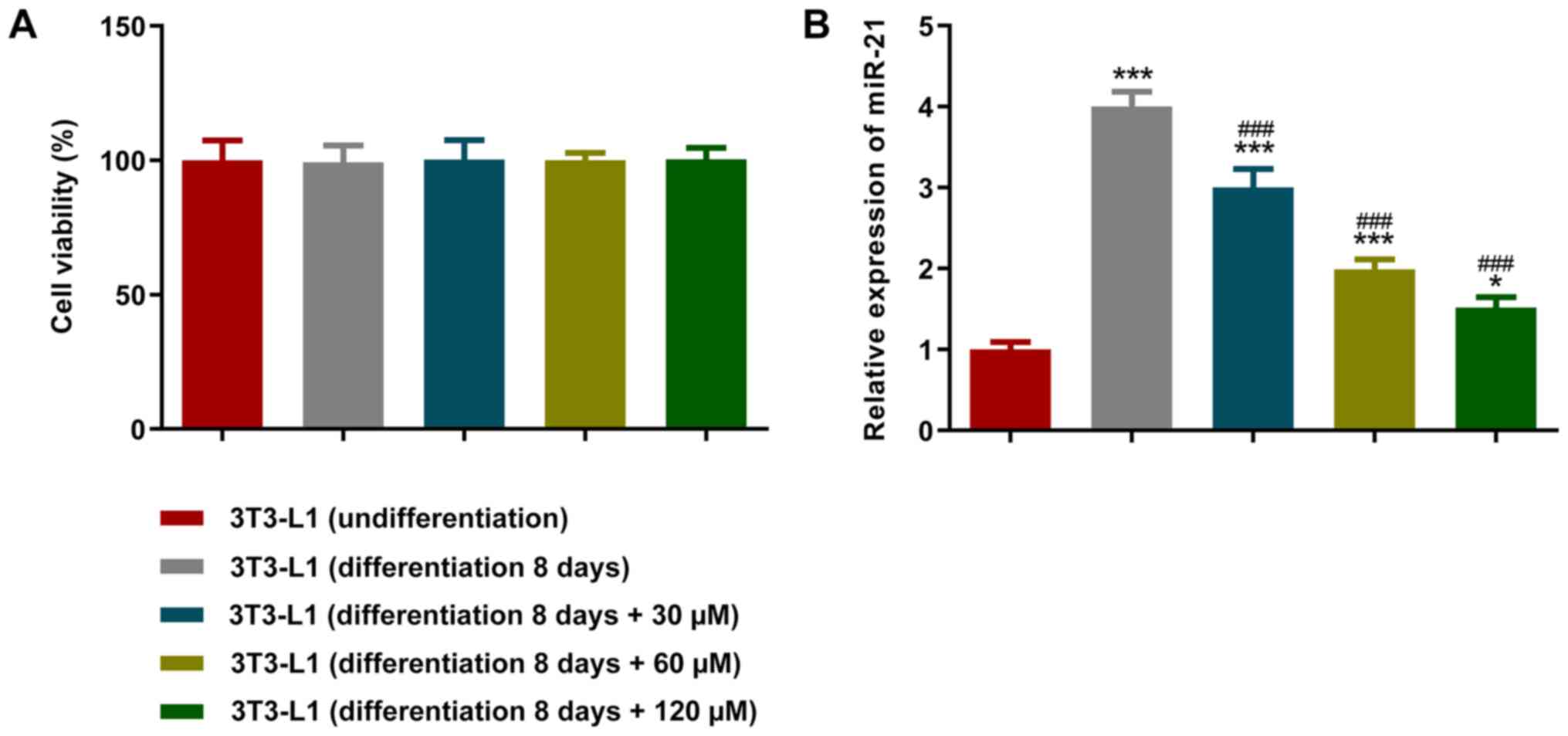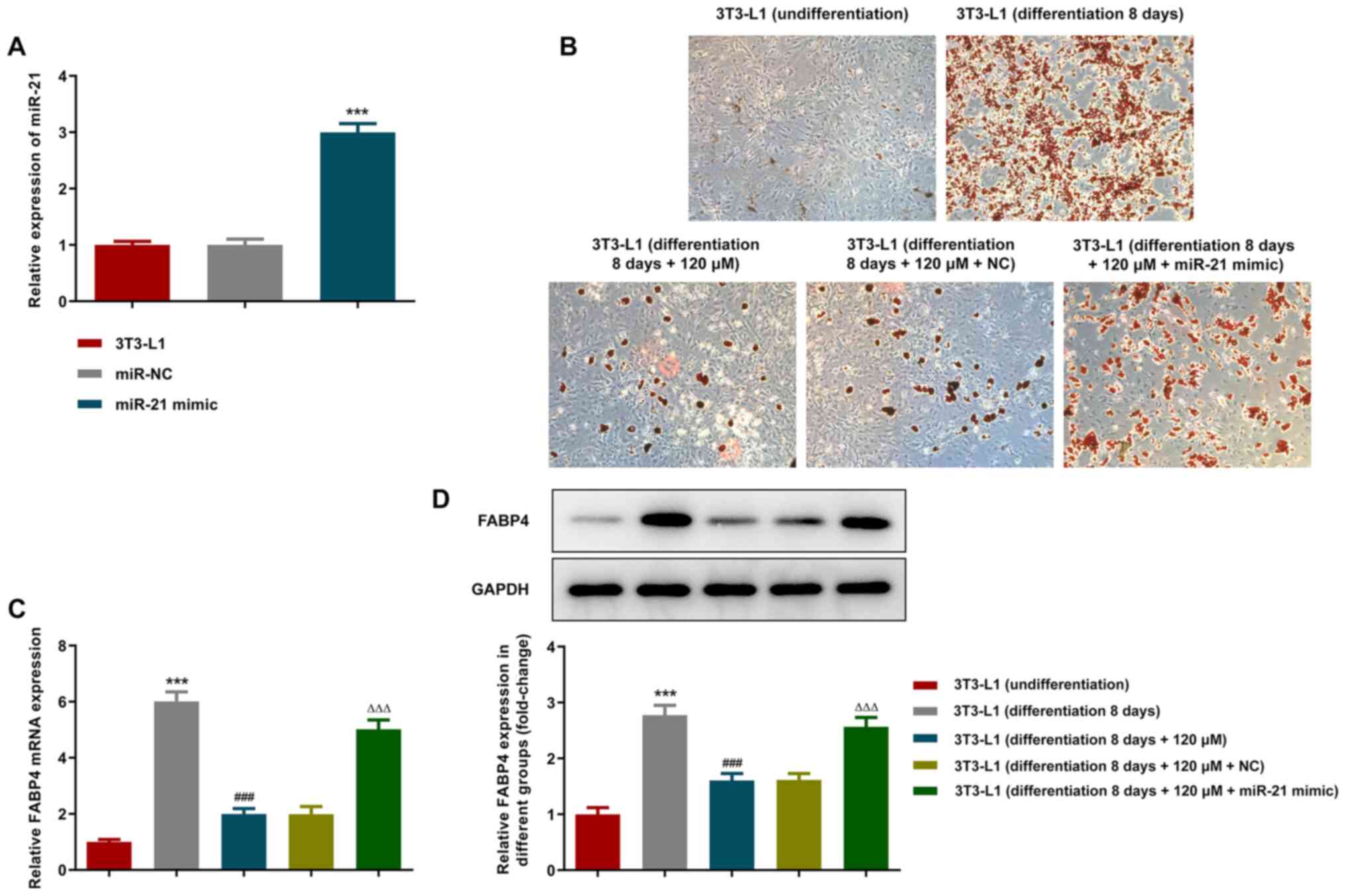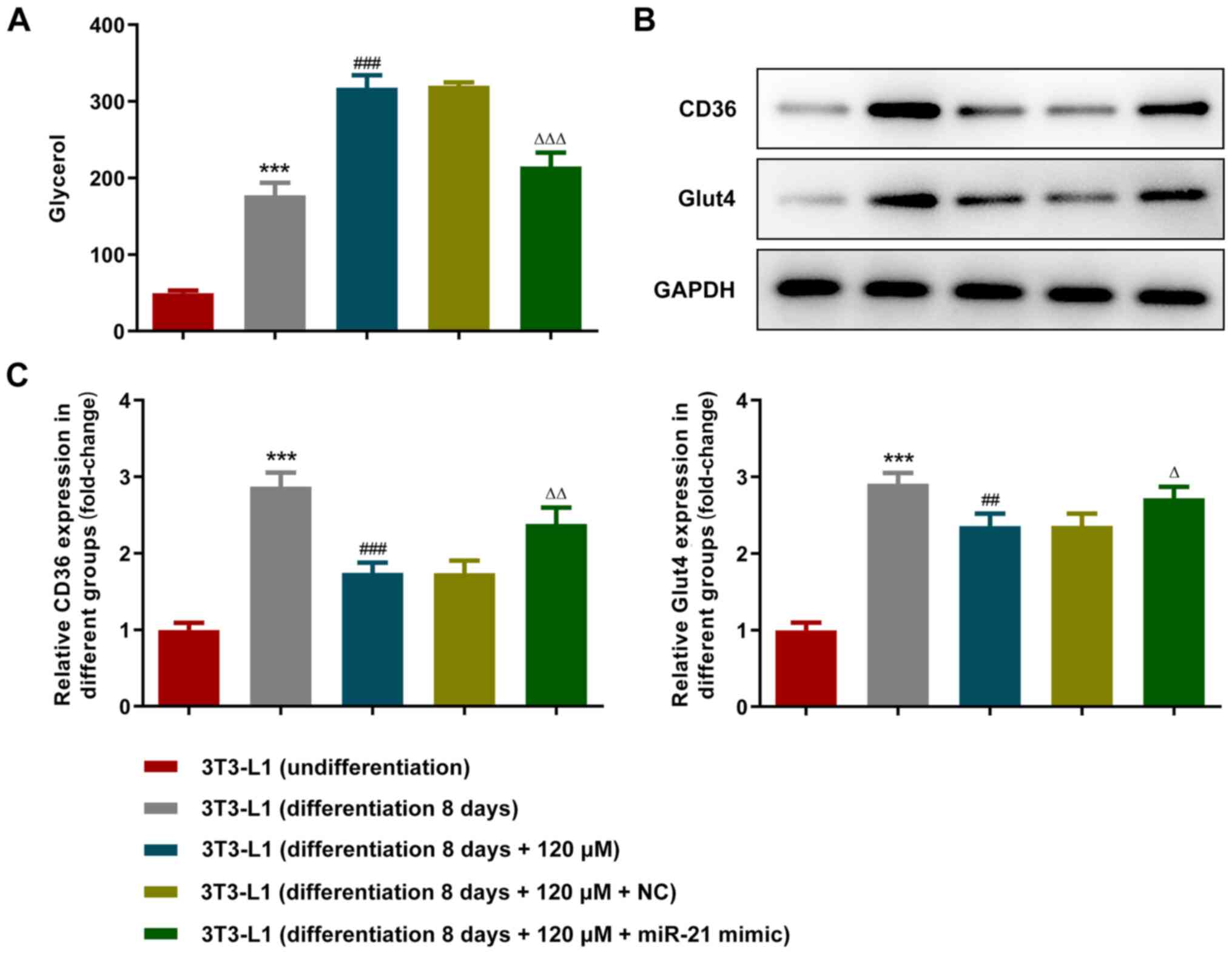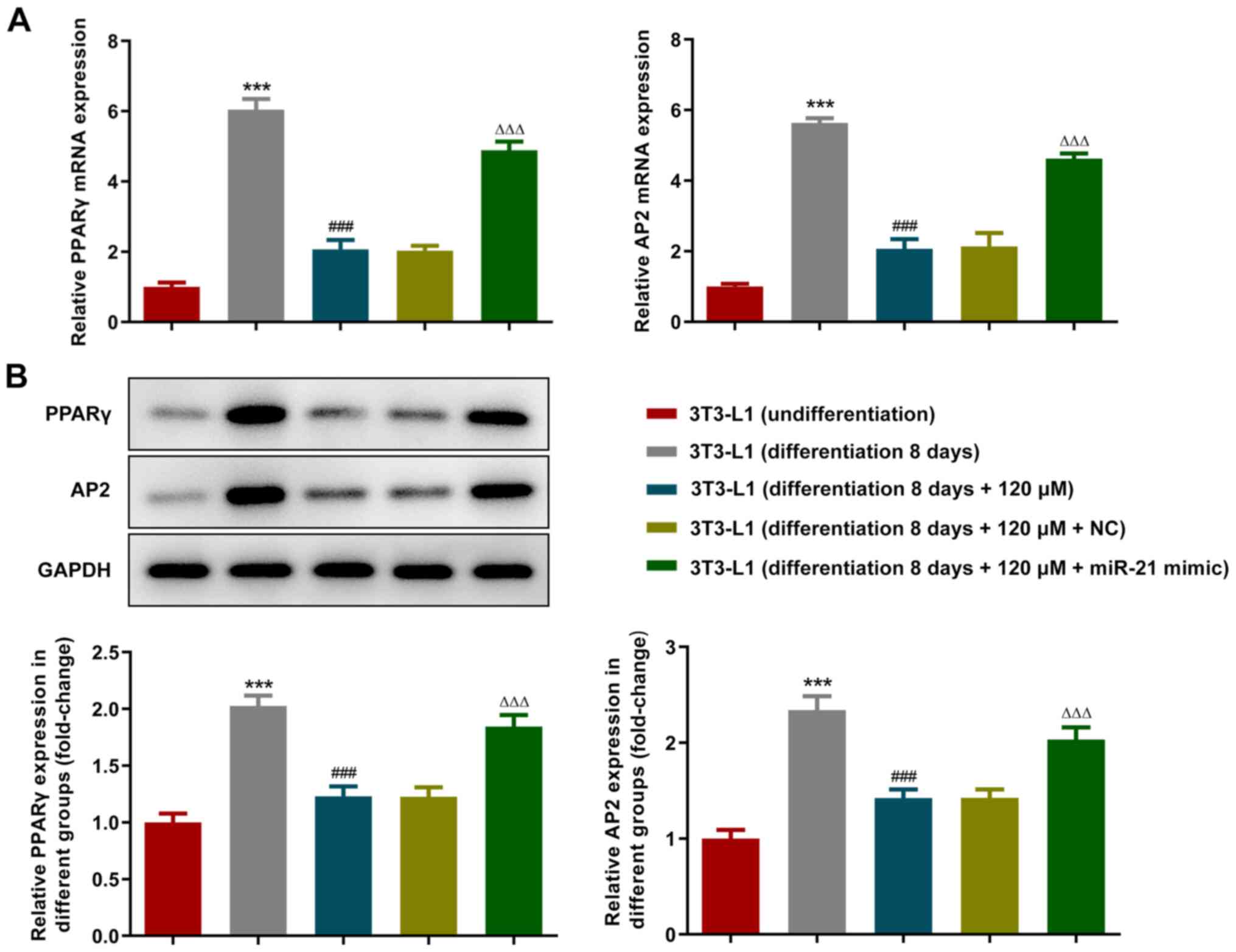|
1
|
Masukume G, O'Neill SM, Baker PN, Kenny
LC, Morton SMB and Khashan AS: The impact of Caesarean section on
the risk of childhood overweight and obesity: new evidence from a
contemporary cohort study. Sci Rep. 8(15113)2018.PubMed/NCBI View Article : Google Scholar
|
|
2
|
Wang L, Wang H, Zhang B, Popkin BM and Du
S: Elevated fat intake increases body weight and the risk of
overweight and obesity among Chinese adults: 1991-2015 trends.
Nutrients. 12(3272)2020.PubMed/NCBI View Article : Google Scholar
|
|
3
|
Akici N, Onal ZE, Gürbüz T, Sağ C and
Kilinç S: Atherogenic indices in the assessment of cardiovascular
disease risk in children with obesity and subclinical
hypothyroidism. Acta Endocrinol (Bucur). 16:334–338.
2020.PubMed/NCBI View Article : Google Scholar
|
|
4
|
Izumi M, Yoshida T, Nakamura T and
Wakamori AM: Paeonol, an Ingredient of Kamishoyosan, Reduces
Intracellular Lipid Accumulation by Inhibiting Glucocorticoid
Receptor Activity in 3T3-L1 Cells. Nutrients. 12(12)2020.PubMed/NCBI View Article : Google Scholar
|
|
5
|
Al-Taher AY, Morsy MA, Rifaai RA, Zenhom
NM and Abdel-Gaber SA: Paeonol attenuates methotrexate-induced
cardiac toxicity in rats by inhibiting oxidative stress and
suppressing TLR4-induced NF-κB inflammatory pathway. Mediators
Inflamm. 2020(8641026)2020.PubMed/NCBI View Article : Google Scholar
|
|
6
|
Ramachandhiran D, Vinothkumar V and
Babukumar S: Paeonol exhibits anti-tumor effects by apoptotic and
anti-inflammatory activities in 7,12-dimethylbenz(a)anthracene
induced oral carcinogenesis. Biotech Histochem. 94:10–25.
2019.PubMed/NCBI View Article : Google Scholar
|
|
7
|
Adki KM and Kulkarni YA: Neuroprotective
effect of paeonol in streptozotocin-induced diabetes in rats. Life
Sci. 271(119202)2021.PubMed/NCBI View Article : Google Scholar
|
|
8
|
Xu F, Xiao H, Liu R, Yang Y, Zhang M, Chen
L, Chen Z, Liu P and Huang H: Paeonol ameliorates glucose and lipid
metabolism in experimental diabetes by activating Akt. Front
Pharmacol. 10(261)2019.PubMed/NCBI View Article : Google Scholar
|
|
9
|
Ping M, Xiao W, Mo L, Xiao X, Song S, Tang
W and Yang X: Paeonol attenuates advanced oxidation protein
product-induced oxidative stress injury in THP-1 macrophages.
Pharmacology. 93:286–295. 2014.PubMed/NCBI View Article : Google Scholar
|
|
10
|
Li H, Dai M and Jia W: Paeonol attenuates
high-fat-diet-induced atherosclerosis in rabbits by
anti-inflammatory activity. Planta Med. 75:7–11. 2009.PubMed/NCBI View Article : Google Scholar
|
|
11
|
Yu Y, Yan R, Chen X, Sun T and Yan J:
Paeonol suppresses the effect of ox-LDL on mice vascular
endothelial cells by regulating miR-338-3p/TET2 axis in
atherosclerosis. Mol Cell Biochem. 475:127–135. 2020.PubMed/NCBI View Article : Google Scholar
|
|
12
|
Zhong LJ, Xie ZS, Yang H, Li P and Xu XJ:
Moutan Cortex and Paeoniae Radix Rubra reverse
high-fat-diet-induced metabolic disorder and restore gut microbiota
homeostasis. Chin J Nat Med. 15:210–219. 2017.PubMed/NCBI View Article : Google Scholar
|
|
13
|
Melkman-Zehavi T, Oren R, Kredo-Russo S,
Shapira T, Mandelbaum AD, Rivkin N, Nir T, Lennox KA, Behlke MA,
Dor Y, et al: miRNAs control insulin content in pancreatic β-cells
via downregulation of transcriptional repressors. EMBO J.
30:835–845. 2011.PubMed/NCBI View Article : Google Scholar
|
|
14
|
Ma E, Fu Y and Garvey WT: Relationship of
circulating miRNAs with insulin sensitivity and associated
metabolic risk factors in humans. Metab Syndr Relat Disord.
16:82–89. 2018.PubMed/NCBI View Article : Google Scholar
|
|
15
|
Lang H, Xiang Y, Lin N, Ai Z, You Z, Xiao
J, Liu D and Yang Y: Identification of a panel of miRNAs as
positive regulators of insulin release in pancreatic β-cells. Cell
Physiol Biochem. 48:185–193. 2018.PubMed/NCBI View Article : Google Scholar
|
|
16
|
Meng S, Cao JT, Zhang B, Zhou Q, Shen CX
and Wang CQ: Downregulation of microRNA-126 in endothelial
progenitor cells from diabetes patients, impairs their functional
properties, via target gene Spred-1. J Mol Cell Cardiol. 53:64–72.
2012.PubMed/NCBI View Article : Google Scholar
|
|
17
|
Tomé-Carneiro J, Larrosa M, Yáñez-Gascón
MJ, Dávalos A, Gil-Zamorano J, Gonzálvez M, García-Almagro FJ, Ruiz
Ros JA, Tomás-Barberán FA, Espín JC, et al: One-year
supplementation with a grape extract containing resveratrol
modulates inflammatory-related microRNAs and cytokines expression
in peripheral blood mononuclear cells of type 2 diabetes and
hypertensive patients with coronary artery disease. Pharmacol Res.
72:69–82. 2013.PubMed/NCBI View Article : Google Scholar
|
|
18
|
Liu YR, Chen JJ and Dai M: Paeonol
protects rat vascular endothelial cells from ox-LDL-induced injury
in vitro via downregulating microRNA-21 expression and TNF-α
release. Acta Pharmacol Sin. 35:483–488. 2014.PubMed/NCBI View Article : Google Scholar
|
|
19
|
Kang M, Yan LM, Zhang WY, Li YM, Tang AZ
and Ou HS: Role of microRNA-21 in regulating 3T3-L1 adipocyte
differentiation and adiponectin expression. Mol Biol Rep.
40:5027–5034. 2013.PubMed/NCBI View Article : Google Scholar
|
|
20
|
Livak KJ and Schmittgen TD: Analysis of
relative gene expression data using real-time quantitative PCR and
the 2(-Delta Delta C(T)) method. Methods. 25:402–408.
2001.PubMed/NCBI View Article : Google Scholar
|
|
21
|
Mitterberger MC, Lechner S, Mattesich M,
Kaiser A, Probst D, Wenger N, Pierer G and Zwerschke W: DLK1(PREF1)
is a negative regulator of adipogenesis in
CD105+/CD90+/CD34+/CD31-/FABP4-
adipose-derived stromal cells from subcutaneous abdominal fat pats
of adult women. Stem Cell Res. 9:35–48. 2012.PubMed/NCBI View Article : Google Scholar
|
|
22
|
Lee SC, Lee YJ, Shin MK and Sung JS:
Regulation of CXCR6 expression on adipocytes and osteoblasts
differentiated from human adipose tissue-derived mesenchymal stem
cells. Stem Cells Int. 2020(8870133)2020.PubMed/NCBI View Article : Google Scholar
|
|
23
|
Jiang R, Yang T, Zhang Y, Wang Z and Zhang
T: LKB1 promotes the transformation of bone marrow mesenchymal stem
cells into adipocytes under oxidative stress via AMPK-mTOR
signaling pathway. J Interferon Cytokine Res. 40:370–376.
2020.PubMed/NCBI View Article : Google Scholar
|
|
24
|
Zhang J, Cai B, Ma M, Luo W, Zhang Z,
Zhang X and Nie Q: ALDH1A1 inhibits chicken preadipocytes'
proliferation and differentiation via the PPARγ pathway in vitro
and in vivo. Int J Mol Sci. 21(3150)2020.PubMed/NCBI View Article : Google Scholar
|
|
25
|
Pacifici F, Farias CLA, Rea S, Capuani B,
Feraco A, Coppola A, Mammi C, Pastore D, Abete P, Rovella V, et al:
Tyrosol may prevent obesity by inhibiting adipogenesis in 3T3-L1
preadipocytes. Oxid Med Cell Longev. 2020(4794780)2020.PubMed/NCBI View Article : Google Scholar
|
|
26
|
Son Y, Cox JM, Stevenson JL, Cooper JA and
Paton CM: Angiopoietin-1 protects 3T3-L1 preadipocytes from
saturated fatty acid-induced cell death. Nutr Res. 76:20–28.
2020.PubMed/NCBI View Article : Google Scholar
|
|
27
|
Kurt S, Gürkan CG, Keleş Tezal GC, Çiftçi
A, Gürgör PN, Güler Ş and Çetinkaya BÖ: Histopathological and
biochemical evaluation of the effect of Paeoniflorin on the
periodontium during and after periodontitis formation in rats. Arch
Oral Biol. 102:135–140. 2019.PubMed/NCBI View Article : Google Scholar
|
|
28
|
Ni J, Yang D, Song L and Li C: Protective
effects of paeoniflorin on alveolar bone resorption and soft-tissue
breakdown in experimental periodontitis. J Periodontal Res.
51:257–264. 2016.PubMed/NCBI View Article : Google Scholar
|
|
29
|
Qiu J, Chen M, Liu J, Huang X, Chen J,
Zhou L, Ma J, Sextius P, Pena AM, Cai Z, et al: The
skin-depigmenting potential of Paeonia lactiflora root extract and
paeoniflorin: In vitro evaluation using reconstructed pigmented
human epidermis. Int J Cosmet Sci. 38:444–451. 2016.PubMed/NCBI View Article : Google Scholar
|
|
30
|
Baek K and Baek JH: The transcription
factors myeloid elf-1-like factor (MEF) and distal-less homeobox 5
(Dlx5) inversely regulate the differentiation of osteoblasts and
adipocytes in bone marrow. Adipocyte. 2:50–54. 2013.PubMed/NCBI View Article : Google Scholar
|
|
31
|
Wang P, Ji R, Ji J and Chen F: Changes of
metabolites of acrylamide and glycidamide in acrylamide-exposed
rats pretreated with blueberry anthocyanins extract. Food Chem.
274:611–619. 2019.PubMed/NCBI View Article : Google Scholar
|
|
32
|
Kim JH, Lee S, Kim HY and Cho EJ: Acer
okamotoanum inhibits adipocyte differentiation by the regulation of
adipogenesis and lipolysis in 3T3-L1 cells. Int J Mol Med.
45:589–596. 2020.PubMed/NCBI View Article : Google Scholar
|
|
33
|
Curcio CA, Johnson M, Rudolf M and Huang
JD: The oil spill in ageing Bruch membrane. Br J Ophthalmol.
95:1638–1645. 2011.PubMed/NCBI View Article : Google Scholar
|
|
34
|
Liu HY, Zhang YY, Zhu BL, Feng FZ, Yan H,
Zhang HY and Zhou B: miR-21 regulates the proliferation and
apoptosis of ovarian cancer cells through PTEN/PI3K/AKT. Eur Rev
Med Pharmacol Sci. 23:4149–4155. 2019.PubMed/NCBI View Article : Google Scholar
|















